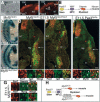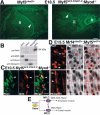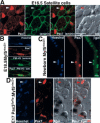Pax3/Pax7 mark a novel population of primitive myogenic cells during development
- PMID: 15964993
- PMCID: PMC1151658
- DOI: 10.1101/gad.345505
Pax3/Pax7 mark a novel population of primitive myogenic cells during development
Abstract
Skeletal muscle serves as a paradigm for the acquisition of cell fate, yet the relationship between primitive cell populations and emerging myoblasts has remained elusive. We identify a novel population of resident Pax3+/Pax7+, muscle marker-negative cells throughout development. Using mouse mutants that uncouple myogenic progression, we show that these Pax+ cells give rise to muscle progenitors. In the absence of skeletal muscle, they apoptose after down-regulation of Pax7. Furthermore, they mark the emergence of satellite cells during fetal development, and do not require Pax3 function. These findings identify critical cell populations during lineage restriction, and provide a framework for defining myogenic cell states for therapeutic studies.
Figures




References
-
- Armand O., Boutineau, A.M., Mauger, A., Pautou, M.P., and Kieny, M. 1983. Origin of satellite cells in avian skeletal muscles. Arch. Anat. Microsc. Morphol. Exp. 72: 163-181. - PubMed
-
- Ben-Yair R. and Kalcheim, C. 2005. Lineage analysis of the avian dermomyotome sheet reveals the existence of single cells with both dermal and muscle progenitor fates. Development 132: 689-701. - PubMed
-
- Bonner P.H. and Hauschka, S.D. 1974. Clonal analysis of vertebrate myogenesis. I. Early developmental events in the chick limb. Dev. Biol. 37: 317-328. - PubMed
-
- Christ B. and Ordahl, C.P. 1995. Early stages of chick somite development. Anat. Embryol. 191: 381-396. - PubMed
Publication types
MeSH terms
Substances
LinkOut - more resources
Full Text Sources
Other Literature Sources
Molecular Biology Databases
